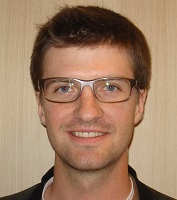keywords :Transparent conductive materials, Silver nanowires, Percolation
Click here to see the jury membersAbstract Transparent electrodes attract intense attention in many technological fields, including optoelectronic devices (solar cells, LEDs, touch screens), transparent film heaters (TFHs) and electromagnetic (EM) applications. New generation transparent electrodes are expected to have three main physical properties: high electrical conductivity, high transparency and high mechanical flexibility. The most efficient and widely-used transparent conducting material is currently indium tin oxide (ITO). However the scarcity of indium associated with ITO’s lack of flexibility and the relatively high manufacturing costs have prompted search into alternative materials. With their outstanding physical properties, silver nanowire (AgNW)-based percolating networks appear to be one of the most promising alternatives to ITO. They also have several other advantages, such as solution-based processing, and compatibility with large area deposition techniques. First cost estimates are lower for AgNW based technology compared to current ITO fabrication processes. Unlike ITO, AgNW are indeed directly compatible with solution processes, never requiring vacuum conditions. Moreover, due to very large aspect ratio of the NWs, smaller quantities of raw materials are needed to reach industrial performance criteria.
The present thesis aims at investigating important physical assets of AgNW networks – unexplored (or not explored enough) so far – in order to increase the robustness, reliability, and industrial compatibility of such technology. This thesis work investigates first optimization methods to decrease the electrical resistance of AgNW networks. In situ electrical measurements performed during thermal ramp annealing and/or chemical treatments provided useful information regarding the activation process at the NW-NW junctions. At the scale of the entire network, our ability to distinguish NW areas taking part in the electrical conduction from inactive areas is a critical issue. In the case where the network density is close to the percolation threshold, a discontinuous activation process of efficient percolating pathways through the network was evidenced, giving rise to a geometrical quantized percolation phenomenon. More generally, the influence of several parameters (networks density, applied voltage, optimization level) on the electrical and thermal homogeneity and stability of AgNW networks is investigated via a dual approach combining electrical mapping techniques and simulations. A thermal runaway process leading to a vertical crack and associated to electrical failure at high voltage could be visually evidenced via in situ electrical mapping of AgNW networks during voltage plateaus. Moreover, many efforts using Matlab and Comsol softwares were devoted to construct reliable models able to fit with experimental results. Due to the increasing demand for portable and wearable electronics, preliminary tests were also conducted to investigate the stretching capability of AgNW networks when transferred to elastomeric substrates. Finally, integrations of AgNW networks in several devices were performed. Specifically, studies were conducted to understand the mechanisms leading to failure in AgNW-based transparent film heaters, and to improve their overall stability. Preliminary investigations of the benefits of incorporating of AgNW networks into electromagnetic devices such as antennas and EM shielding devices are also discussed at the end of the manuscript.
jury members :Prof. Y. Bréchet SIMaP, CNRS, Grenoble INP, Grenoble (France) Président
Dr. P. Poulin CRPP, CNRS, Univ. Bordeaux, Bordeaux (France) Rapporteur
Dr. D. Vuillaume IEMN, CNRS, Univ. Lille 1, Lille (France) Rapporteur
Dr. L. Balan IS2M, CNRS, Univ. Haute-Alsace, Mulhouse (France) Examinateur
Dr. M. Creyssels MFAE/LMFA, Ecole Centrale de Lyon, Lyon (France) Examinateur
Prof. L. Flandin LEPMI, Univ. Savoie Mont-Blanc, Le Bourget-du-Lac (France) Examinateur
Dr. J.-P. Simonato CEA-Liten, Grenoble (France) Directeur de thèse
Dr. C. Celle CEA-Liten, Grenoble (France) Co-encadrante de thèse
Date infos
2:00 pm - Room Chrome 1 – 1er Floor
Location infos
Maison Minatec,
3 Parvis Louis Néel
38000 Grenoble
